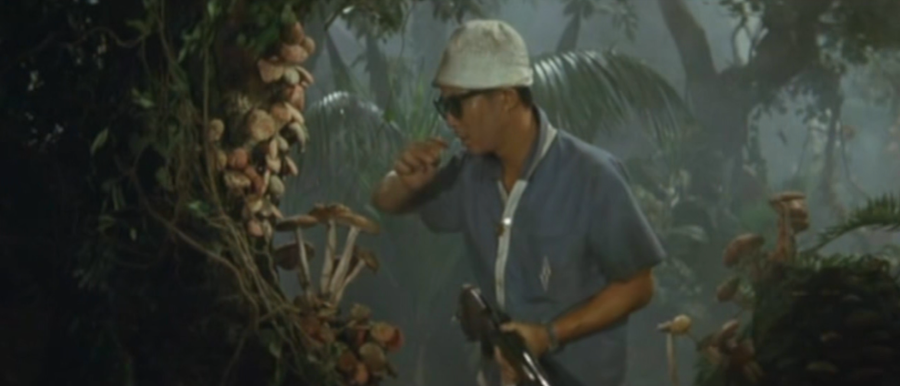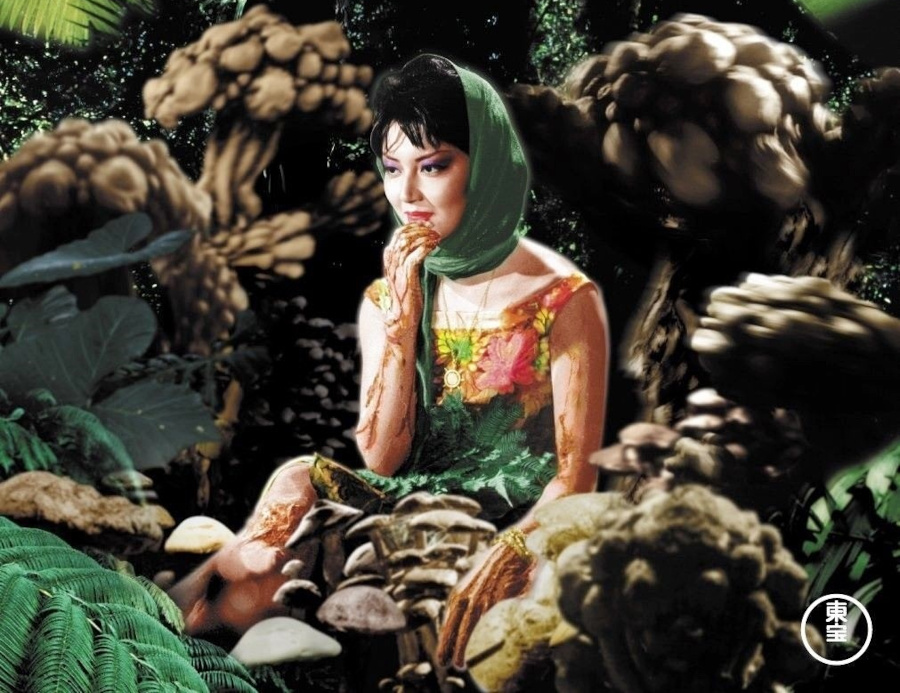Today (August 11, 2023) marks the 60th anniversary of Matango! Brought to you by Ishirō Honda (director of Godzilla and other beloved faves!), this truly unique Japanese horror film didn’t come to the United States until 1965, two years after its theatrical release in Japan — where it was retitled Attack of the Mushroom People!
This eerie tale of castaways on a fog-covered island has it all: Isolation, paranoia, betrayals, body horror, and monstrous practical FX transformations that put a whole new spin on “you are what you eat.”
Read On Below or Jump To...
Matango Takes a Simple Concept and Makes It Unforgettable

Matango/Attack of the Mushroom People starts off in a darkened room with the lone survivor of…something… being questioned in a mental institution. It then flashes back to (literally and figuratively) brighter times, as jaunty music accompanies images of a sailing ship and lighthearted young people frolicking on deck.
Given the 1960s time period, and the seven people out for a fateful cruise on a charter ship, the mental comparisons to Gilligan’s Island are inevitable. The dubbed version of the film adds to the inherent goofiness as some of the lines are just a little “off” to unintentionally humorous effect; however, the original (subtitled, for English speakers/readers) opening scenes are still a striking contrast mood-wise to the horrors to come.
Much like The Minnow, the doomed ship in Matango ends up on a deserted island and the seven passengers now have to do whatever they can to survive.
But they aren’t the first castaways to land there! They discover another ship – crew missing – with a stern warning in the previous Captain’s Log: Do NOT eat the mushrooms on the island!!

The catch? The entire island is covered in mushrooms and little else.
As with any “deserted island” horror story, the isolation and lack of resources begin to drive the castaways to madness. They also begin to betray each other, as characters grow more desperate and selfish. And there’s the growing paranoia that something is OUT THERE — watching!
Matango Is Mushroom Horror At Its Finest!
When Matango came out on August 11, 1963 there weren’t a whole lot of mushroom-centric horror films out. And although The Last of Us (as a video game in 2013 and a show in 2023) made the genre a little less obscure, it’s still pretty “out there” as far as horror concepts!
You see, anyone who gives in and eats the mushrooms on the island in Matango becomes mushrooms themselves!

I’m aware that “mushroom” iconography took on an entirely different meaning in Japan after 1945 — and Matango was nearly banned from release because some of the prosthetic makeup effects too closely resembled the disfigurements experienced by the victims of the atomic bombings. And that definitely adds another layer of real-world horror to what makes Attack of the Mushroom People so haunting and memorable.
However, I tend to look at things in a very literal way and don’t dig deeper until rewatches. So, when I was first introduced to this fine film, my main horror takeaway from an island full of mushrooms was essentially this: They’re on an island full of food that they can’t eat!
At the time, I was no fan of mushrooms myself (I’ve since grown to appreciate them greatly as a source of Vitamin D); however, I had been a member of the local Anime Club and had a lifelong appreciation for Japanese pop culture. Given that mushrooms are a food staple in Japan and that many of the mushrooms are considered delicious delicacies, the castaways in Matango — in USA terms — are essentially surrounded by charbroiled cheeseburgers …but they have to eat the roots off of grass and raw eggs instead.

Is it any wonder they’re driven to madness? To atrocious deeds?! These people are HANGRY! The absolute bone chilling horror of being surrounded by scrumptious treats, comfort food faves, the staple of your childhood dinner table and knowing if you give in and have even a taste you’ll turn into a monster…!! Oh, my God. I can’t even. Seriously.
And as most of the characters do, inevitably, lose control and dig in, their gradual transformation into mushroom-like beings brings about a new sense of loss of control — this time over their own bodies and identities. The anxiety of becoming something unrecognizable taps into one of our most primal fears as it is; but things get even worse when one character brings up this little gem: “If I’m no longer human, then I’m not committing any crimes.”
Fans of The Purge series know exactly how brutal humans can get when consequences are no longer tied to actions!
Matango/Attack of the Mushroom People Continues to Inspire, 60 Years Later!
There’s something about Matango that captures the imagination of every person who watches it. My dad, Rob Tharp, used to watch Attack of the Mushroom People when it would play on TV back in the late 1960s and 1970s. Unfortunately, by the 1990s, it had all but disappeared from the public eye… Until its 40th (USA) anniversary DVD release!
Dad was finally able to introduce this Japanese horror movie gem to his family. I was quite taken with it:
As was my mom, Cathy Tharp:

You may remember from previous posts that my mom was an FX artist and worked for Don Post Studios for decades. She was an immediate fan of Matango and sculpted + painted that mask!
Mini Interview: Cathy Tharp on Her Matango Mask
I knew Mom would want to be a part of today’s 60th anniversary celebration of Matango/Attack of the Mushroom People, so I asked if she could share a little about her mask and love for the film:
“Although, the Japanese film Matango or Attack of the Mushroom People had been airing on American TV since the mid-sixties, I had never seen it. I watched it for the first time in 2005 and loved it. The mushroom people inspired me so much, that I decided to sculpt a fan art mask of the main mushroom man which showed up on board the ship in the film.
~Cathy Tharp
Since mushrooms had been a recurring subject matter theme in my artwork since the ‘70s, it seemed like a natural choice for me. I had a great time with it and it turned out well. Only a few copies exist in the private collections of myself and a few friends. This mask was never available to the general public.”
Here’s the scene Mom was talking about, it appears at exactly 44:49 in the movie and NOT ONE SECOND LONGER (there are other instances of mushroom dudes in Matango, but they’re different than this guy mom was so taken with):

And here’s another look at Mom’s Matango mask fan art, on display in our home:

If YOU have your own Matango/Attack of the Mushroom People fan art, be sure to hit me up on @LoveHorrorFam on Twitter/X and Instagram so I can see it too! ♥
Have You Watched Matango…?

Matango is currently streaming on Tubi. Just be aware that it’s the dubbed version! While most things remain consistent between the dubbed and “subbed”/subtitled versions, there’s one KEY difference: the closing monologue. I love both versions, but it DOES change a rather drastic detail, just by rewriting one line.
Got your curiosity up? Good! Now you’ll have to watch both versions. 😉
The eerie undeniably weird atmosphere, the mounting dread, the outstanding practical effects, and the little flickers of “did that tree just move?” will keep your eyes glued to the screen. And, don’t worry, no matter which version you watch, the “La la la” ukulele song is the same.
Happy 60th anniversary, Matango!!
Become a Patron!Images were purchased via MovieStillsDB, CineMaterial, or screengrabbed from our legally owned copy of the film. These images were used for review purposes. Photos of Cathy Tharp’s Matango mask were provided by her as well as the ancient scan of her daughter’s drawing.





